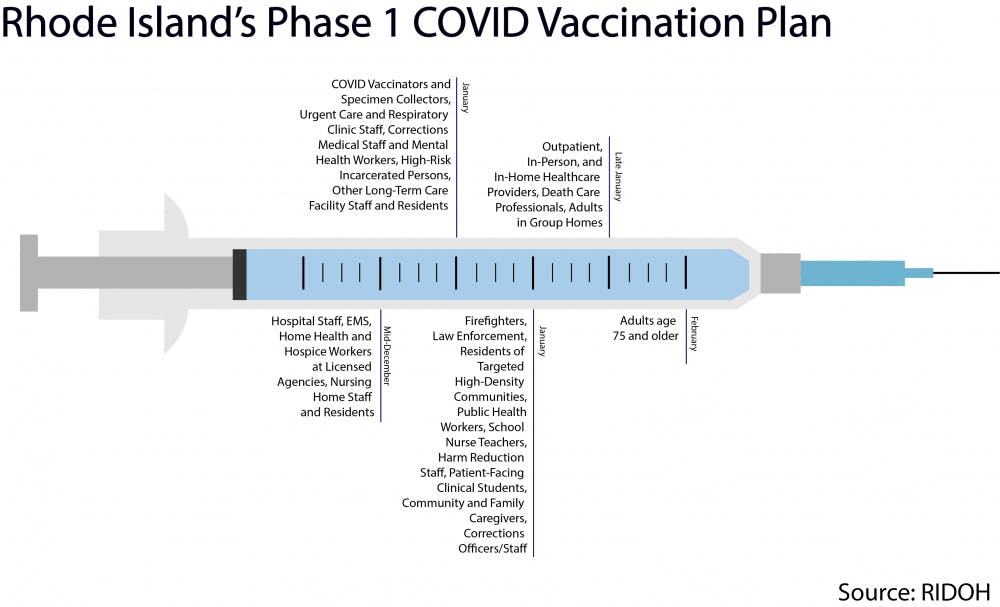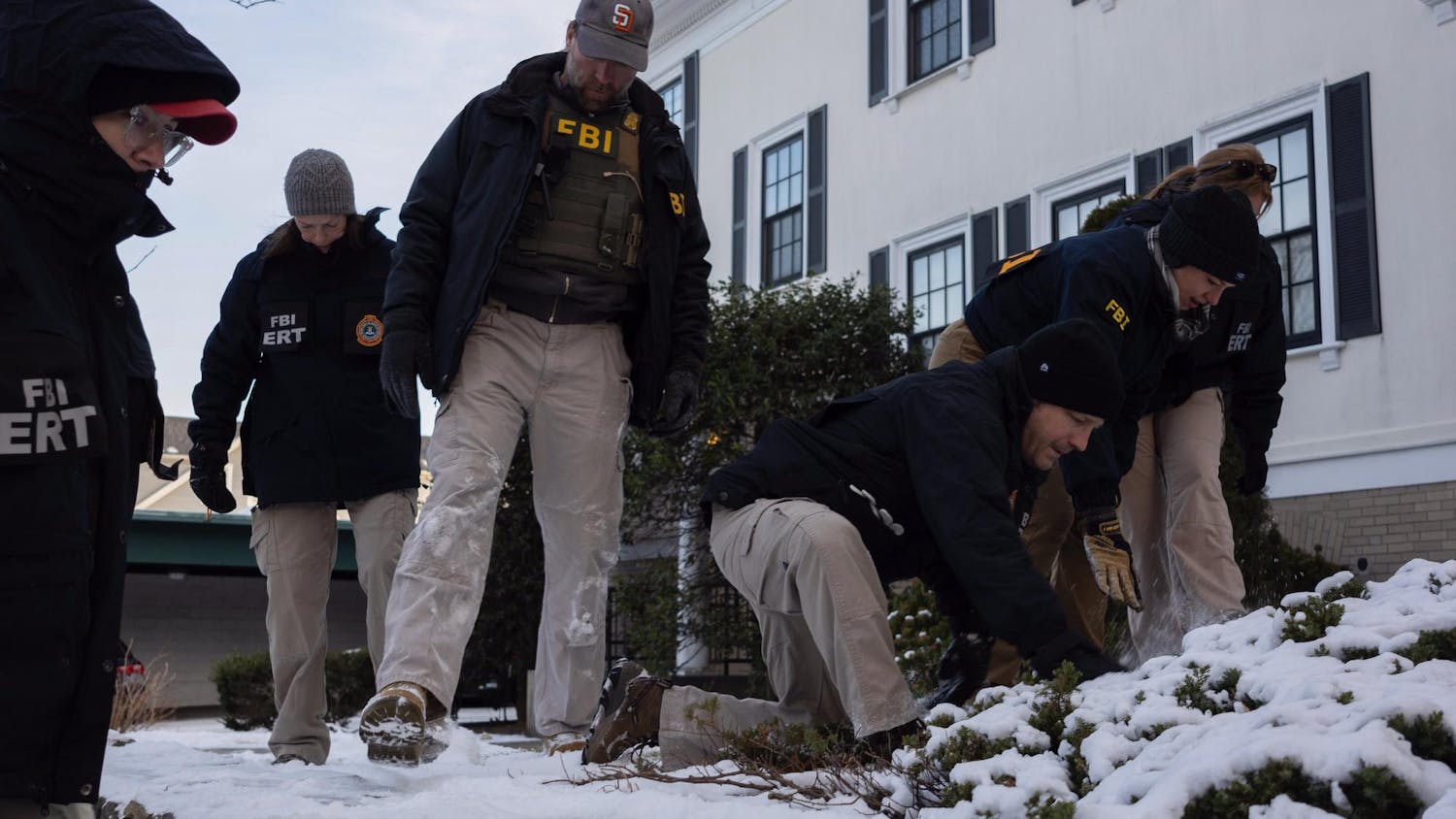With limited supply of vaccines in Rhode Island, state officials have backed a three-phased prioritization plan to determine who receives doses first, with a focus on equity and minimizing hospitalizations.
More than 66,000 COVID-19 vaccine doses have been administered in Rhode Island, according to statistics from the Rhode Island Department of Health.
The two COVID-19 vaccines that have been granted Emergency Use Authorization by the Food and Drug Administration — produced by Pfizer and Moderna — each require two doses administered a few weeks apart for a recipient to gain full immunity. Approximately 52,000 people have received their first dose in the state, and 13,000 have been fully vaccinated.
Currently, Rhode Island is in Phase 1 of its vaccine rollout. Nursing home residents and hospital workers are among those who have been vaccinated, said Philip Chan, consultant medical director for RIDOH and associate professor of medicine at the University, during a RIDOH press update Jan. 21.
Some members of the Brown community have begun to receive the vaccine during Phase 1 of distribution, Vanessa Britto MSc ’96, associate vice president for campus life and executive director of health and wellness, told The Herald. Health Services members, patient-facing medical students, members of University Emergency Medical Services and of University Department of Public Safety are actively receiving the vaccine, Britto said.
Patients who are 75 and older are also included in Phase 1, Public Information Officer for RIDOH Joseph Wendelken told The Herald. The state expects to begin vaccinating those individuals by early to mid-February, he added.
But limited supply has stymied the vaccine rollout, said RIDOH Director Nicole Alexander-Scott MPH ’11 during Gov. Gina Raimondo’s Jan. 13 press briefing. “The biggest challenge facing Rhode Island, like most other states throughout the country, is that we are not receiving a lot of vaccine supply right now,” Alexander-Scott said.
Rhode Island receives approximately 14,000 vaccines per week from the federal government, Alexander-Scott said, enough to inoculate roughly 1.5 percent of the population each week.
“We are doing the best we can with the supply we have,” Alexander-Scott said, adding that Rhode Island ranks near the top of states in doses administered per capita.
Limited supply of the vaccine has also prevented the state from expanding eligibility. Chan said that Rhode Island would like to make the vaccine immediately available to all individuals 65 years and older, as the Trump and Biden administrations have recommended. But according to Chan, such a policy would not be feasible, as proven by other states which have attempted to make the vaccine universally available to that age bracket.
“As more vaccines come in, we’ll be able to scale up and (administer) to more people at more locations,” Wendelken said. RIDOH is exploring different venues at which to vaccinate individuals 75 and older, such as pharmacies, regional clinics or senior centers.
Phase 2
With Phase 1 underway, the Rhode Island Vaccine Subcommittee discussed its proposal for population prioritization in Phase 2 of the state’s vaccination campaign during its Jan. 22 meeting.
Phase 2 of the state’s vaccination campaign will likely begin in April, according to Wendelken. The prioritization for Phase 2 is organized primarily based on age with older individuals receiving priority, said McKenzie Morton, the subcommittee meeting facilitator for RIDOH.
The committee is composed of local experts, including epidemiologists, doctors and members of the faith community, and has given RIDOH guidance on different population considerations during the vaccine prioritization process, Wendelken said.
The Phase 2 plan is not yet set in stone — the finalized proposal will be presented at the next vaccine subcommittee meeting on Feb. 5.
Three principles guided the development of the proposed Phase 2 prioritization, Morton said: reducing deaths and hospitalizations across the state, focusing on equity and reopening the economy.
The state will also accelerate distribution to individuals whose health conditions put them at a higher risk for severe illness from COVID-19 and individuals who live in areas with higher rates of hospitalization and death, Morton said. This proposal aligns closely with recommendations given by the Centers for Disease Control and Prevention, she added.
“We have a major focus on equity,” Wendelken said. “COVID-19 has not impacted every community in the same way. … We want to be vaccinating in areas that have been hardest hit by COVID-19.”
When determining prioritization based on underlying health conditions, RIDOH built upon the CDC’s list of medical conditions which put people at greater risk for severe illness from COVID-19, Morton said. RIDOH compared the population prevalence of each medical condition with the percentage of the people hospitalized for COVID-19 who have that condition. For example, renal disease has a 2 percent population prevalence in Rhode Island, but is represented in 22 percent of all COVID-19 hospital admissions, Morton said.
RIDOH found four underlying medical conditions that are among the most common in those hospitalized for COVID-19: renal disease, cardiac disease, lung disease and diabetes, prompting the state to prioritize vaccinating individuals with these conditions.
Jonathan Brice, superintendent of the Bristol Warren Regional School District and a member of the vaccine subcommittee, noted at the Jan. 22 meeting that the Phase 2 proposal does not prioritize vaccinating individuals who may be at higher risk of contracting COVID-19 based on occupation, including school teachers. Multiple other subcommittee members raised similar concerns.
Alexander-Scott said at the meeting that prioritizing high-risk conditions and geography covers most at-risk teachers without having to prioritize by occupation.
But the Phase 2 prioritization plan could still change, said Courtney Hawkins, director of the Rhode Island Department of Human Services and a member of the vaccine subcommittee, at the meeting. If more supply becomes available, or if the Biden administration directs states to target certain occupational groups, then Rhode Island would be able to incorporate those changes into the existing vaccine strategy, Hawkins said.
With additional reporting credit by Livia Gimenes

ADVERTISEMENT




